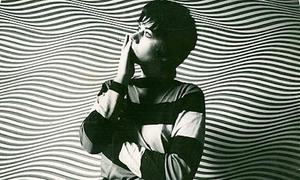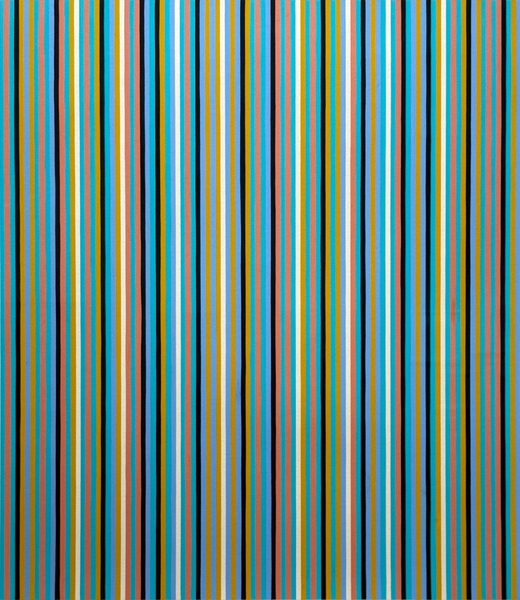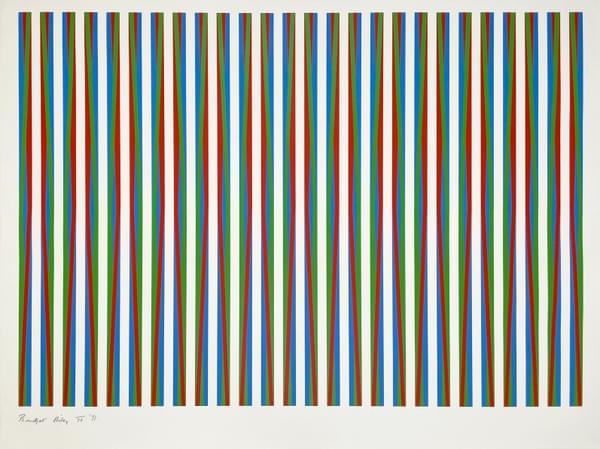Bridget Riley
Bridget Riley created some of the most era-defining images in the history of art, her black and white optical art provided a visual summary for 'Swinging London'. By 1960 and approaching her late-twenties, Riley had settled into a dynamic style of hard-edged abstraction with, often, wild optical properties. She came to international attention in 1965 when her work was included in MoMA’s famous exhibition The Responsive Eye, presenting her pictures with other artists of the Op Art movement, and illustrating her painting Current on the cover. She worked almost exclusively in a black, white and grey palette until 1967, when colour was allowed into her work and the first of the famous stripe paintings was produced. In the following year she represented Great Britain at the Venice Biennale for which she received the International Painting Prize.
Throughout her career, Riley has exhibited an unwavering commitment to experimentation and innovation. She has continuously pushed the boundaries of her practice, exploring various techniques and approaches to create fresh and exciting work. Her rigorous investigation of colour interaction, line and form has resulted in a diverse oeuvre that encompasses paintings, prints and murals.
Riley's significance extends beyond her technical prowess and aesthetic achievements. Her contributions to hard-edge abstraction have had a transformative impact on the entire field of contemporary art. By developing mastery of a visually dynamic style that relies on optical illusions, something first explored by many artists internationally during the 1950s, Riley challenged traditional notions of representation and perception. Her work opened new avenues of artistic exploration, inspiring countless artists and paving the way for subsequent generations of abstract and conceptual artists.
In Britain, Riley's influence has been particularly profound. Her early exhibitions at the Hayward and Tate Galleries in London catapulted her to prominence, making her a central figure in the British art scene. Abundant and frequent retrospectives of her work have been presented internationally at leading institutions from her mid-career period onwards.
Bridget Riley is considered to be one of the most important artists living and working in Britain.
Featured Artists
- Albers Anni
- Ancart Harold
- Andre Carl
- Avery Milton
- Baldessari John
- Barnes Ernie
- Calder Alexander
- Castellani Enrico
- Clough Prunella
- Crawford Brett
- Dadamaino
- de Tollenaere Saskia
- Dyson Julian
- Elsner Slawomir
- Freud Lucian
- Gadsby Eric
- Gander Ryan
- Guston Philip
- Haring Keith
- Hartung Hans
- Hayes David
- Held Al
- Hepworth Barbara
- Hill Anthony
- Hitchens Ivon
- Hockney David
- Hutchinson Norman Douglas
- Jenney Neil
- Katz Alex
- Kentridge William
- Knifer Julije
- Kusama Yayoi
- Le Parc Julio
- Leciejewski Edgar
- Léger Fernand
- Levine Chris
- Marchéllo
- Martin Kenneth
- Mavignier Almir da Silva
- Miller Harland
- Mitchell Joan
- Modé João
- Moore Henry
- Morellet François
- Nadelman Elie
- Nara Yoshitomo
- Nesbitt Lowell Blair
- Nicholson Ben
- O'Donoghue Hughie
- Pasmore Victor
- Perry Grayson
- Picasso Pablo
- Pickstone Sarah
- Prehistoric Objects
- Riley Bridget
- Ruscha Ed
- Sedgley Peter
- Serra Richard
- Shrigley David
- Smith Anj
- Smith Richard
- Soto Jesús Rafael
- Soulages Pierre
- Spencer Stanley
- Taller Popular de Serigrafía
- The Connor Brothers
- Vasarely Victor
- Vaughan Keith
- Whiteread Rachel
- Wood Jonas



